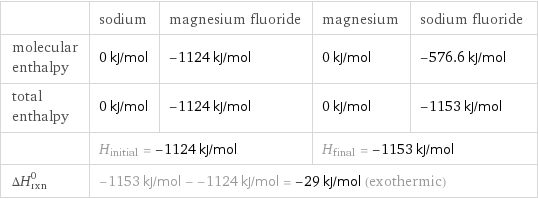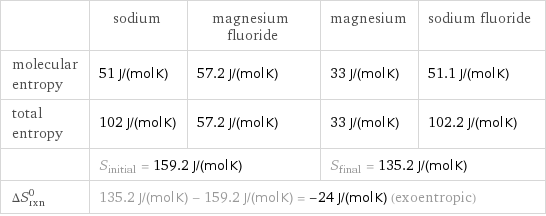Input interpretation

Na sodium + MgF_2 magnesium fluoride ⟶ Mg magnesium + NaF sodium fluoride
Balanced equation

Balance the chemical equation algebraically: Na + MgF_2 ⟶ Mg + NaF Add stoichiometric coefficients, c_i, to the reactants and products: c_1 Na + c_2 MgF_2 ⟶ c_3 Mg + c_4 NaF Set the number of atoms in the reactants equal to the number of atoms in the products for Na, F and Mg: Na: | c_1 = c_4 F: | 2 c_2 = c_4 Mg: | c_2 = c_3 Since the coefficients are relative quantities and underdetermined, choose a coefficient to set arbitrarily. To keep the coefficients small, the arbitrary value is ordinarily one. For instance, set c_2 = 1 and solve the system of equations for the remaining coefficients: c_1 = 2 c_2 = 1 c_3 = 1 c_4 = 2 Substitute the coefficients into the chemical reaction to obtain the balanced equation: Answer: | | 2 Na + MgF_2 ⟶ Mg + 2 NaF
Structures

+ ⟶ +
Names

sodium + magnesium fluoride ⟶ magnesium + sodium fluoride
Reaction thermodynamics
Enthalpy

| sodium | magnesium fluoride | magnesium | sodium fluoride molecular enthalpy | 0 kJ/mol | -1124 kJ/mol | 0 kJ/mol | -576.6 kJ/mol total enthalpy | 0 kJ/mol | -1124 kJ/mol | 0 kJ/mol | -1153 kJ/mol | H_initial = -1124 kJ/mol | | H_final = -1153 kJ/mol | ΔH_rxn^0 | -1153 kJ/mol - -1124 kJ/mol = -29 kJ/mol (exothermic) | | |
Entropy

| sodium | magnesium fluoride | magnesium | sodium fluoride molecular entropy | 51 J/(mol K) | 57.2 J/(mol K) | 33 J/(mol K) | 51.1 J/(mol K) total entropy | 102 J/(mol K) | 57.2 J/(mol K) | 33 J/(mol K) | 102.2 J/(mol K) | S_initial = 159.2 J/(mol K) | | S_final = 135.2 J/(mol K) | ΔS_rxn^0 | 135.2 J/(mol K) - 159.2 J/(mol K) = -24 J/(mol K) (exoentropic) | | |
Equilibrium constant
![Construct the equilibrium constant, K, expression for: Na + MgF_2 ⟶ Mg + NaF Plan: • Balance the chemical equation. • Determine the stoichiometric numbers. • Assemble the activity expression for each chemical species. • Use the activity expressions to build the equilibrium constant expression. Write the balanced chemical equation: 2 Na + MgF_2 ⟶ Mg + 2 NaF Assign stoichiometric numbers, ν_i, using the stoichiometric coefficients, c_i, from the balanced chemical equation in the following manner: ν_i = -c_i for reactants and ν_i = c_i for products: chemical species | c_i | ν_i Na | 2 | -2 MgF_2 | 1 | -1 Mg | 1 | 1 NaF | 2 | 2 Assemble the activity expressions accounting for the state of matter and ν_i: chemical species | c_i | ν_i | activity expression Na | 2 | -2 | ([Na])^(-2) MgF_2 | 1 | -1 | ([MgF2])^(-1) Mg | 1 | 1 | [Mg] NaF | 2 | 2 | ([NaF])^2 The equilibrium constant symbol in the concentration basis is: K_c Mulitply the activity expressions to arrive at the K_c expression: Answer: | | K_c = ([Na])^(-2) ([MgF2])^(-1) [Mg] ([NaF])^2 = ([Mg] ([NaF])^2)/(([Na])^2 [MgF2])](../image_source/e0a223d95561df26f1ad4177ecf6af08.png)
Construct the equilibrium constant, K, expression for: Na + MgF_2 ⟶ Mg + NaF Plan: • Balance the chemical equation. • Determine the stoichiometric numbers. • Assemble the activity expression for each chemical species. • Use the activity expressions to build the equilibrium constant expression. Write the balanced chemical equation: 2 Na + MgF_2 ⟶ Mg + 2 NaF Assign stoichiometric numbers, ν_i, using the stoichiometric coefficients, c_i, from the balanced chemical equation in the following manner: ν_i = -c_i for reactants and ν_i = c_i for products: chemical species | c_i | ν_i Na | 2 | -2 MgF_2 | 1 | -1 Mg | 1 | 1 NaF | 2 | 2 Assemble the activity expressions accounting for the state of matter and ν_i: chemical species | c_i | ν_i | activity expression Na | 2 | -2 | ([Na])^(-2) MgF_2 | 1 | -1 | ([MgF2])^(-1) Mg | 1 | 1 | [Mg] NaF | 2 | 2 | ([NaF])^2 The equilibrium constant symbol in the concentration basis is: K_c Mulitply the activity expressions to arrive at the K_c expression: Answer: | | K_c = ([Na])^(-2) ([MgF2])^(-1) [Mg] ([NaF])^2 = ([Mg] ([NaF])^2)/(([Na])^2 [MgF2])
Rate of reaction
![Construct the rate of reaction expression for: Na + MgF_2 ⟶ Mg + NaF Plan: • Balance the chemical equation. • Determine the stoichiometric numbers. • Assemble the rate term for each chemical species. • Write the rate of reaction expression. Write the balanced chemical equation: 2 Na + MgF_2 ⟶ Mg + 2 NaF Assign stoichiometric numbers, ν_i, using the stoichiometric coefficients, c_i, from the balanced chemical equation in the following manner: ν_i = -c_i for reactants and ν_i = c_i for products: chemical species | c_i | ν_i Na | 2 | -2 MgF_2 | 1 | -1 Mg | 1 | 1 NaF | 2 | 2 The rate term for each chemical species, B_i, is 1/ν_i(Δ[B_i])/(Δt) where [B_i] is the amount concentration and t is time: chemical species | c_i | ν_i | rate term Na | 2 | -2 | -1/2 (Δ[Na])/(Δt) MgF_2 | 1 | -1 | -(Δ[MgF2])/(Δt) Mg | 1 | 1 | (Δ[Mg])/(Δt) NaF | 2 | 2 | 1/2 (Δ[NaF])/(Δt) (for infinitesimal rate of change, replace Δ with d) Set the rate terms equal to each other to arrive at the rate expression: Answer: | | rate = -1/2 (Δ[Na])/(Δt) = -(Δ[MgF2])/(Δt) = (Δ[Mg])/(Δt) = 1/2 (Δ[NaF])/(Δt) (assuming constant volume and no accumulation of intermediates or side products)](../image_source/00ad78ab42cd339c9744af150aeeece7.png)
Construct the rate of reaction expression for: Na + MgF_2 ⟶ Mg + NaF Plan: • Balance the chemical equation. • Determine the stoichiometric numbers. • Assemble the rate term for each chemical species. • Write the rate of reaction expression. Write the balanced chemical equation: 2 Na + MgF_2 ⟶ Mg + 2 NaF Assign stoichiometric numbers, ν_i, using the stoichiometric coefficients, c_i, from the balanced chemical equation in the following manner: ν_i = -c_i for reactants and ν_i = c_i for products: chemical species | c_i | ν_i Na | 2 | -2 MgF_2 | 1 | -1 Mg | 1 | 1 NaF | 2 | 2 The rate term for each chemical species, B_i, is 1/ν_i(Δ[B_i])/(Δt) where [B_i] is the amount concentration and t is time: chemical species | c_i | ν_i | rate term Na | 2 | -2 | -1/2 (Δ[Na])/(Δt) MgF_2 | 1 | -1 | -(Δ[MgF2])/(Δt) Mg | 1 | 1 | (Δ[Mg])/(Δt) NaF | 2 | 2 | 1/2 (Δ[NaF])/(Δt) (for infinitesimal rate of change, replace Δ with d) Set the rate terms equal to each other to arrive at the rate expression: Answer: | | rate = -1/2 (Δ[Na])/(Δt) = -(Δ[MgF2])/(Δt) = (Δ[Mg])/(Δt) = 1/2 (Δ[NaF])/(Δt) (assuming constant volume and no accumulation of intermediates or side products)
Chemical names and formulas

| sodium | magnesium fluoride | magnesium | sodium fluoride formula | Na | MgF_2 | Mg | NaF Hill formula | Na | F_2Mg | Mg | FNa name | sodium | magnesium fluoride | magnesium | sodium fluoride IUPAC name | sodium | magnesium difluoride | magnesium | sodium fluoride